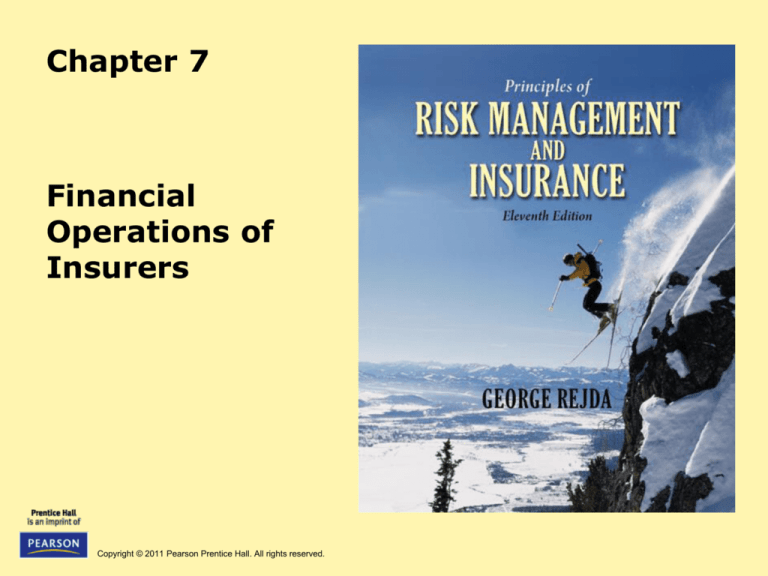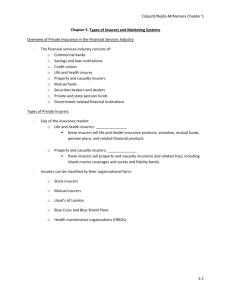
Chapter 7
Financial
Operations of
Insurers
Copyright © 2011 Pearson Prentice Hall. All rights reserved.
Agenda
•
•
•
•
•
Property and Casualty Insurers
Life Insurance Companies
Ratemaking in Property and Casualty Insurance
Ratemaking in Life Insurance
The Financial Crisis and Insurers
Copyright © 2011 Pearson Prentice Hall. All rights reserved.
7-2
Financial Statements of Property and
Casualty Insurers
• Balance Sheet: a summary of what a company
owns (assets) and what it owes (liabilities)
Total Assets = Total Liabilities + Owners’ Equity
Copyright © 2011 Pearson Prentice Hall. All rights reserved.
7-3
Exhibit 7.1 ABC Insurance Company
Copyright © 2011 Pearson Prentice Hall. All rights reserved.
7-4
Financial Statements of Property and
Casualty Insurers
• The primary assets for an insurance
company are financial assets
• Insurers’ liabilities include required reserves
• A loss reserve is an estimated amount for:
• Claims reported and adjusted, but not yet paid
• Claims reported and filed, but not yet adjusted
• Claims incurred but not yet reported to the company
Copyright © 2011 Pearson Prentice Hall. All rights reserved.
7-5
Financial Statements of Property and
Casualty Insurers
• Case reserves are loss reserves that are
established for each individual claim
– Methods for determining case reserves include:
• The judgment method: a claim reserve is established
for each individual claim
• The average value method: an average value is
assigned to each claim
• The tabular method: loss reserves are determined for
certain claims for which the amounts paid depend on
data derived from mortality, morbidity, and
remarriage tables
Copyright © 2011 Pearson Prentice Hall. All rights reserved.
7-6
Financial Statements of Property and
Casualty Insurers
• The loss ratio method establishes
aggregate loss reserves for a specific
coverage line
– A formula based on the expected loss ratio is
used to estimate the loss reserve
• The incurred-but-not-reported (IBNR)
reserve is a reserve that must be
established for claims that have already
occurred but that have not yet been
reported
Copyright © 2011 Pearson Prentice Hall. All rights reserved.
7-7
Financial Statements of Property and
Casualty Insurers
• The unearned premium reserve is a liability item
that represents the unearned portion of gross
premiums on all outstanding policies at the time of
valuation
– Its purpose is to pay for losses that occur during the policy
period
– It is also needed so that refunds can be paid to
policyholders that cancel their coverage
– It also serves as the basis for determining the amount that
must be paid to a reinsurer for carrying reinsured polices
– The annual pro rata method is one method of calculating
the reserve
Copyright © 2011 Pearson Prentice Hall. All rights reserved.
7-8
Financial Statements of Property and
Casualty Insurers
• Policyholders’ surplus is the difference between an
insurance company’s assets and liabilities
– The stronger a company’s surplus position, the greater is
the security for its policyholders
Copyright © 2011 Pearson Prentice Hall. All rights reserved.
7-9
Financial Statements of Property and
Casualty Insurers
• The income and expense statement summarizes
revenues and expenses paid over a specified period
of time
• The two principal sources of revenue are premiums
and investment income
– Earned premiums are those premiums for which the service
for which the premiums were paid (insurance protection)
has been rendered
• Expenses include the cost of adjusting claims,
paying the insured losses that occurred,
commissions to agents, premium taxes, and general
insurance expenses
Copyright © 2011 Pearson Prentice Hall. All rights reserved.
7-10
Exhibit 7.2 ABC Insurance Company
Copyright © 2011 Pearson Prentice Hall. All rights reserved.
7-11
Measuring the Performance of Property
and Casualty Insurers
• The loss ratio is the ratio of incurred losses and loss
adjustment expenses to premiums earned
Loss Ratio
Incurred Losses Loss Adjustment Expenses
Premiums Earned
• The expense ratio is equal to the company’s
underwriting expenses divided by written premiums
Expense Ratio
Underwriting Expenses
Premiums Written
• The combined ratio is the sum of the loss ratio and
the expense ratio. A positive ratio indicates an
underwriting loss
Copyright © 2011 Pearson Prentice Hall. All rights reserved.
7-12
Measuring the Performance of Property
and Casualty Insurers
• The investment income ratio compares net
investment income to earned premiums
Investment Income Ratio
Net Investment Income
Earned Premiums
• The overall operating ratio is equal to the combined
ratio minus the investment income ratio
– This ratio measures the company’s total performance
(underwriting and investments)
Copyright © 2011 Pearson Prentice Hall. All rights reserved.
7-13
Financial Statements of
Life Insurers
• The balance sheet
– The assets of a life insurer have a longer
duration, on average, than those of property
and casualty insurers
– Because many life insurance policies have a
savings element, life insurers keep an interestbearing asset called “contract loans” or “policy
loans”
– A life insurance company may have separate
accounts for assets backing interest-sensitive
products, such as variable annuities
Copyright © 2011 Pearson Prentice Hall. All rights reserved.
7-14
Financial Statements of
Life Insurers
• Policy reserves are a liability item on the balance
sheet that must be offset by assets equal to that
amount
– State laws specify the minimum basis for calculating policy
reserves
• The reserve for amounts held on deposit is a
liability representing funds that are owed to
policyholders and to beneficiaries
• The asset valuation reserve is a statutory
accounting account designed to absorb asset value
fluctuations not caused by changing interest rates
Copyright © 2011 Pearson Prentice Hall. All rights reserved.
7-15
Financial Statements of
Life Insurers
• Policyholders’ surplus is less volatile in the life
insurance industry than in the property and casualty
insurance industry
• Benefit payments, including death benefits paid to
beneficiaries and annuity benefits paid to
annuitants, are the life insurer’s major expense
• A life insurer’s net gain from operations equals total
revenues less total expenses, policyowner
dividends, and federal income taxes
Copyright © 2011 Pearson Prentice Hall. All rights reserved.
7-16
Measuring the Performance of Life
Insurers
• A number of measures can be used to
gauge the performance of life insurers
– Pre-tax or after-tax net income vs. total assets
– Rate of return on policyowners’ surplus
Copyright © 2011 Pearson Prentice Hall. All rights reserved.
7-17
Ratemaking in Property and Casualty
Insurance
• State Laws Require:
– Rates should be adequate for paying all losses
and expenses
– Rates should not be excessive, such that
policyholders are paying more than the actual
value of their protection
– Rates must not be unfairly discriminatory;
exposures that are similar with respect to losses
and expenses should not be charged significantly
different rates
Copyright © 2011 Pearson Prentice Hall. All rights reserved.
7-18
Ratemaking in Property and Casualty
Insurance
• Business Rate-Making Objectives include:
– Rates should be easy to understand.
– Rates should be stable over short periods of
time
– Rates should be responsive to changing loss
exposures and changing economic conditions
– Rates should encourage loss prevention
Copyright © 2011 Pearson Prentice Hall. All rights reserved.
7-19
Ratemaking in Property and Casualty
Insurance
• A rate is the price per unit of insurance.
• An exposure unit is the unit of measurement used in insurance
pricing, e.g., a car-year
• The pure premium is the portion of the rate needed to pay
losses and loss adjustment expenses
• Loading is the amount that must be added to the pure
premium for other expenses, profit, and a margin for
contingencies
• The gross rate consists of the pure premium and a loading
element
• The gross premium paid by the insured consists of the gross
rate multiplied by the number of exposure units
Copyright © 2011 Pearson Prentice Hall. All rights reserved.
7-20
Ratemaking in Property and Casualty
Insurance
•
There are three basic rate making
methods in property and casualty
insurance:
1. Judgment rating means that each exposure is
individually evaluated, and the rate is
determined largely by the judgment of the
underwriter
2. Class rating means that exposures with
similar characteristics are placed in the same
underwriting class, and each is charged the
same rate
Copyright © 2011 Pearson Prentice Hall. All rights reserved.
7-21
Ratemaking in Property and Casualty
Insurance
– Class rates are determined using two basic
methods:
• Under the pure premium method, the pure premium
can be determined by dividing the dollar amount of
incurred losses and loss-adjustment expenses by the
number of exposure units
• Under the loss ratio method, the actual loss ratio is
compared with the expected loss ratio, and the rate is
adjusted accordingly
Copyright © 2011 Pearson Prentice Hall. All rights reserved.
7-22
Ratemaking in Property and Casualty
Insurance
3. Merit rating is a rating plan by which class rates
are adjusted upward or downward based on
individual loss experience
•
Under a schedule rating plan, each exposure is
individually rated
–
–
A basis rate is determined for each exposure, which is
then modified by debits or credits depending on the
physical characteristics of the exposure
Commonly used in commercial property insurance
Copyright © 2011 Pearson Prentice Hall. All rights reserved.
7-23
Ratemaking in Property and Casualty
Insurance
• Under experience rating, the class or manual rate is
adjusted upward or downward based on past loss
experience
– The insurer’s past loss experience is used to determine the
premium for the next policy period
• Under a retrospective rating plan, the insured’s loss
experience during the current policy period determines
the actual premium paid for that period
– A provisional premium is paid at the beginning of the policy
period; the final premium is calculated at the end of the
policy period
– Commonly used in workers compensation insurance
Copyright © 2011 Pearson Prentice Hall. All rights reserved.
7-24
Ratemaking in Life Insurance
• Life insurance actuaries use a mortality table or
individual company experience to determine the
probability of death at each attained age
• The annual expected value of death claims equals
the probability of death times the amount the
insurer must pay if death occurs
Copyright © 2011 Pearson Prentice Hall. All rights reserved.
7-25
The Financial Crisis and Insurers
• The recent financial crisis has affected financial
institutions in different ways
– Banks were more negatively impacted as they issued the
sub prime mortgage loans
– Insurers were not heavily involved in sub prime lending
– Insurers did not securitize the bad mortgage loans and
mortgage debt was not a significant share of insurers’
investment portfolios
– Insurers were most affected by the sharp decline in the
value of their investment portfolios
Copyright © 2011 Pearson Prentice Hall. All rights reserved.
7-26








